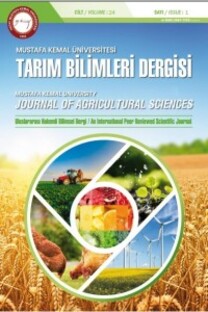Agricultural residues potential of Hatay
___
Anonymous (2018a) TUIK Statistical Table of Agricultural Land. Retrieved August 6, 2019, from https://biruni.tuik.gov.tr/medas/?kn=92&locale=trAnonymous (2018b) TUIK Crop Production Statistics: All districts of Hatay province. Retrieved May 6, 2019, from https://biruni.tuik.gov.tr/medas/?kn=92&locale=tr
Başçetinçelik A, Karaca C, Öztürk HH, Kaçıra M, Ekinci K (2005) Agricultural Biomass Potential in Turkey. Proceedings of the 9. International Congress on Mechanization and Energy in Agriculture & 27. International Conference of CIGR Section IV: The Efficient Use of Electricity and Renewable Energy Sources in Agriculture, September 27-29, İzmir, Turkey. pp 195-199.
Başçetinçelik A, Öztürk HH, Karaca C, Kaçira M, Ekinci K, Kaya D, Baban A, Komitti N, Barnes I, Nieminen M (2006) A Guide on Exploitation of Agricultural Residues in Turkey. AGRO-WASTE - Exploitation of Agricultural Residues in Turkey. EU Life Program Project, Project No: LIFE03 TCY/TR/000061.
Bilandzija N, Voca N, Kricka T, Matin A, Jurisic V (2012) Energy potential of fruit tree pruned biomass in Croatia. Spanish Journal of Agricultural Research, 10:292-298
Karaca C, Başçetinçelik A (2014) Economic Analysis of Selected Combine Heat and Power (CHP) Plant Based on Cotton Ginning Residue Combustion in Adana. Proceeding of 12th International Congress on Mechanization & Energy in Agriculture, September 3-6, Cappadocia, Turkey. pp 308-313.
Karaca C (2015) Mapping of energy potential through annual crop residues in Turkey. Int J Agric & Biol Eng, 8: 104-109.
Karaca C (2017) Hatay İlinin Hayvansal Gübre Kaynağından Üretilebilir Biyogaz Potansiyelinin Belirlenmesi. MKÜ Ziraat Fakültesi Derg., 22: 34-39.
Karaca C, Gürdil GAK, Öztürk HH (2017) Determining and Mapping Agricultural Biomass Energy Potential in Samsun Province of Turkey. Proceedings of 3rd. International Conference on Environmental Science and Technology (ICOEST), October 19-23 Budapest, Hungary. pp 190-194.
Karaca C, Öztürk HH (2017) The Biomass Energy Potential of Osmaniye Province from Agricultural Residues. Proceedings of International Advanced Researches and Engineering Congress 2017 (IAREC’ 17) November 16-18, Osmaniye, Turkey. pp 2297- 2301.
Karaca C (2018) The Biomass Energy Potential of Balıkesir Province from Agricultural Residues. Proceedings Book III of International Symposium of Bandırma and Its Surroundings, September 17-19, Bandırma, Turkey. pp 469-477.
Velázquez-Martí B, Fernández-González E, López-Cortés I, Callejón-Ferre AJ (2013) Prediction and evaluation of biomass obtained from citrus trees pruning. Journal of Food, Agriculture & Environment. 11: 1485-1491
- ISSN: 1300-9362
- Yayın Aralığı: Yılda 3 Sayı
- Başlangıç: 1996
- Yayıncı: Mustafa Kemal Üniversitesi Ziraat Fakültesi
Ali Demir KESKİNER, Mahmut ÇETİN, Takanori NAGANO
Seralarda soğutma pedi olarak bazı yerel malzemelerin uygunluklarının değerlendirilmesi
Engin GÖNEN, Çağatay TANRIVERDİ, Yeşim BOZKURT ÇOLAK, Attila (ve diğerleri) Yazar, Mete ÖZFİDANER
Gaziantep ili Nizip ilçesi zeytin bahçeleri topraklarının bor durumunun belirlenmesi
Kerim Mesut ÇİMRİN, Mehmet YALÇIN, Neslihan KELEŞ
Hüseyin T. GÜLTAŞ, Yeşim AHİ, Daniyal D. KÖKSAL, Murat KARAER
Effectiveness of GNSS-based tractor auto steering systems in crop spraying
Mustafa TOPÇUERİ, Muharrem KESKİN
Tarımsal yükseköğretimin mevcut durumu ve geleceği
Mehmet Sait KİREMİT, M. Hakan ARSLAN, Alieu SAİDY
Mahmut DOK, Mustafa ACAR, Ayşegül E. ÇELİK, Gülhan ATAGÜN, Ufuk AKBAŞ
